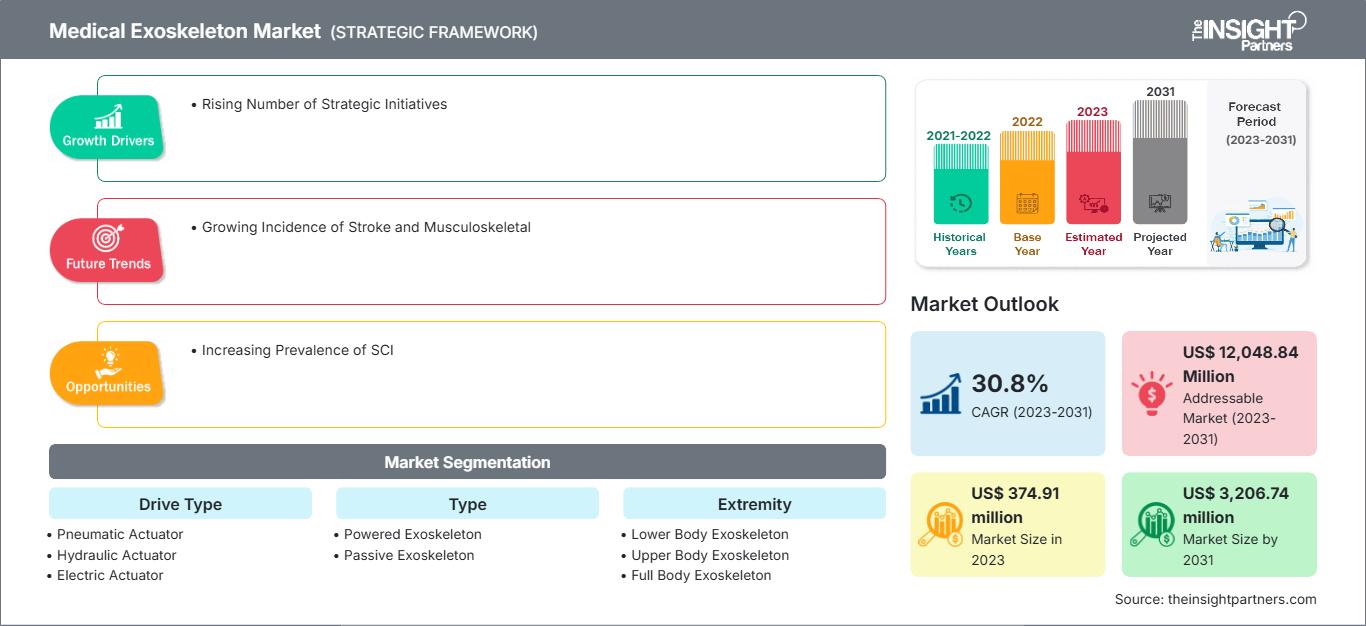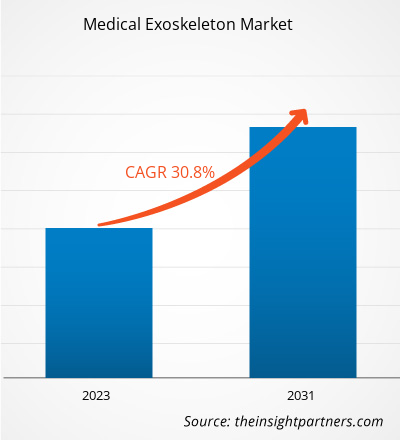Der Markt für medizinische Exoskelette soll von 374,91 Millionen US-Dollar im Jahr 2023 auf 3.206,74 Millionen US-Dollar im Jahr 2031 anwachsen. Für den Markt wird zwischen 2023 und 2031 eine durchschnittliche jährliche Wachstumsrate (CAGR) von 30,8 % erwartet. Zunehmender technologischer Fortschritt und steigende Investitionen werden voraussichtlich auch weiterhin die wichtigsten Trends auf dem Markt bleiben.
Marktanalyse für medizinische Exoskelette
Erkrankungen wie Schlaganfall, Multiple Sklerose und Rückenmarksverletzungen können zu Mobilitätsproblemen führen, weshalb medizinische Exoskelette zur Mobilitätsunterstützung eingesetzt werden. Steigende Investitionen privater Organisationen und staatlicher Stellen in Forschung und Entwicklung zur Verbesserung der Funktionalität und Erschwinglichkeit medizinischer Exoskelette treiben das Marktwachstum weiter voran.
Marktübersicht für medizinische Exoskelette
Immer mehr Startups konzentrieren sich auf die Entwicklung medizinischer Exoskelette für Menschen mit Mobilitätsstörungen der unteren Körperhälfte. So brachte beispielsweise GenElek Technologies, ein Health-Tech-Startup aus Neu-Delhi, im Jahr 2020 ein Roboter-Exoskelett für Menschen mit besonderen Fähigkeiten auf den Markt. Dieses Roboter-Exoskelett ist mit künstlicher Intelligenz kombiniert, um gelähmten Menschen das mühelose Gehen zu ermöglichen. Mithilfe eines Exoskeletts kann ein Gelähmter innerhalb von 11 Tagen nach einem Schlaganfall wieder laufen, wenn er behandelt wird.
Passen Sie diesen Bericht Ihren Anforderungen an
Sie erhalten kostenlos Anpassungen an jedem Bericht, einschließlich Teilen dieses Berichts oder einer Analyse auf Länderebene, eines Excel-Datenpakets sowie tolle Angebote und Rabatte für Start-ups und Universitäten.
Markt für medizinische Exoskelette: Strategische Einblicke

-
Holen Sie sich die wichtigsten Markttrends aus diesem Bericht.Dieses KOSTENLOSE Beispiel umfasst Datenanalysen, die von Markttrends bis hin zu Schätzungen und Prognosen reichen.
Markttreiber und -chancen für medizinische Exoskelette
Steigende Lebenserwartung der alternden Bevölkerung begünstigt den Markt
Heutzutage wird erwartet, dass die meisten Menschen weltweit älter als 60 Jahre werden, was auf eine höhere Lebenserwartung hindeutet. In jedem Land steigt sowohl die Zahl als auch der Anteil älterer Menschen. Laut WHO wird im Jahr 2030 weltweit jeder sechste Mensch 60 Jahre oder älter sein. Die Zahl der über 60-Jährigen wird von einer Milliarde im Jahr 2020 auf 1,4 Milliarden im Jahr 2030 ansteigen. Darüber hinaus wird sich die Weltbevölkerung im Alter von 60 Jahren und älter bis 2050 voraussichtlich verdoppeln und 2,1 Milliarden erreichen. Die Zahl der über 80-Jährigen wird sich zwischen 2020 und 2050 voraussichtlich verdreifachen und bis 2050 426 Milliarden erreichen. Ältere Menschen unterliegen einem höheren Risiko eines Krankenhausaufenthalts als Erwachsene mittleren Alters. Medizinische Exoskelette helfen älteren Menschen, ihre Beweglichkeit zu verbessern und unabhängiger zu werden. Somit begünstigt die alternde Bevölkerung, die nach Operationen Pflege benötigt, das Wachstum des Marktes für medizinische Exoskelette.
Zunehmende Prävalenz von Rückenmarksverletzungen fördert den Markt
Verringerte körperliche Aktivität und das Überwiegen sitzender Tätigkeiten können bei Menschen mit Rückenmarksverletzungen zu schweren physischen und psychischen Schäden führen. Sekundäre Komplikationen infolge einer Rückenmarksverletzung können ebenfalls die Lebenserwartung verringern. Laut der National Library of Medicine erleiden weltweit jährlich fast 250.000–500.000 Patienten eine Rückenmarksverletzung. Laut einem Bericht der Association for Spinal Injury Research, Rehabilitation and Reintegration (Aspire, UK) werden in Großbritannien jährlich etwa 2.500 Menschen mit einer Rückenmarksverletzung diagnostiziert. Derzeit leben in Großbritannien etwa 50.000 Menschen mit diesen Verletzungen. Das National Spinal Cord Injury Statistical Center schätzt, dass in den USA etwa 320.000 Menschen mit traumatischen Rückenmarksverletzungen leben. Eine erhöhte Zahl von Fällen ist darauf zurückzuführen, dass Motocross- und Motorradwettbewerbe zu den weltweit beliebtesten Sportarten zählen, wie aus einem Bericht des National Institute of Health hervorgeht. Laut der WHO sterben weltweit jedes Jahr etwa 1,19 Millionen Menschen bei Verkehrsunfällen, und 20 bis 50 Millionen Menschen erleiden nicht tödliche Verletzungen, viele davon bleiben behindert. Ebenso werden nach Schätzungen der Mayo Clinic etwa 10 % aller Rückenmarksverletzungen durch Sport und athletische Aktivitäten wie Tauchen in flachem Wasser sowie Basketball und Football verursacht. Unternehmen wie Lifeward konzentrieren sich auf die Entwicklung von Exoskeletten, die Patienten mit Rückenmarksverletzungen dabei helfen, körperliche Aktivitäten ohne Schmerzen auszuführen. So kommen etwa 20 % aller Rückenmarksverletzten als Kandidaten für klinische Studien des aktuellen ReWalk Personal Exoskeleton oder ReWalk Rehabilitation Exoskeleton in Frage. Darüber hinaus können weiche Exo-Anzüge in medizinischen Exoskeletten bei Patienten mit Rückenmarksverletzungen eingesetzt werden. Daher ist zu erwarten, dass die zunehmende Prävalenz von Rückenmarksverletzungen und die laufende Forschung zum Einsatz von Exoskeletten bei Patienten mit Rückenmarksverletzungen das Marktwachstum im Prognosezeitraum ankurbeln werden.
Segmentierungsanalyse des Marktberichts für medizinische Exoskelette
Schlüsselsegmente, die zur Ableitung der Marktanalyse für medizinische Exoskelette beigetragen haben, sind Komponente, Typ, Extremität, Anwendung, Mobilität und Endnutzer.
- Basierend auf den Komponenten ist der Markt für medizinische Exoskelette in Hardware und Software unterteilt. Das Hardware-Untersegment ist in Sensoren, Aktoren, Stromquellen, Steuerungssysteme und Sonstiges unterteilt. Aktoren werden weiter in pneumatische Aktoren, hydraulische Aktoren, elektrische Aktoren, mechanische Aktoren, Aktoren mit Formgedächtnislegierungen und Sonstiges unterteilt. Das Hardwaresegment hatte 2023 einen größeren Marktanteil.
- Nach Typ ist der Markt in motorbetriebene Exoskelette und passive Exoskelette unterteilt. Das Segment der motorbetriebenen Exoskelette hatte 2023 einen größeren Marktanteil.
- In Bezug auf Extremitäten ist der Markt für medizinische Exoskelette in Unterkörper-Exoskelette, Oberkörper-Exoskelette und Ganzkörper-Exoskelette unterteilt. Das Segment der Unterkörper-Exoskelette hatte 2023 den größten Marktanteil.
- Basierend auf der Anwendung ist der Markt in Rückenmarksverletzungen, Multiple Sklerose, Schlaganfall, Zerebralparese, Parkinson-Krankheit und andere unterteilt. Das Segment der Rückenmarksverletzungen hatte 2023 den größten Marktanteil.
- Nach Mobilität ist der Markt für medizinische Exoskelette in mobile und stationäre Exoskelette unterteilt. Das Segment der mobilen Exoskelette hatte 2023 einen größeren Marktanteil.
- Basierend auf dem Endnutzer ist der Markt in Rehabilitationszentren, Physiotherapiezentren, Langzeitpflegezentren, häusliche Pflegeeinrichtungen und andere segmentiert. Das Segment der Rehabilitationszentren dominierte den Markt im Jahr 2023.
Marktanteilsanalyse für medizinische Exoskelette nach Geografie
Der geografische Umfang des Marktberichts für medizinische Exoskelette ist hauptsächlich in fünf Regionen unterteilt: Nordamerika, Asien-Pazifik, Europa, Naher Osten und Afrika sowie Süd- und Mittelamerika.
Nordamerika hat den Markt dominiert. Die zunehmende Akzeptanz technologisch fortschrittlicher Produkte, ein Anstieg der Forschungs- und Entwicklungsaktivitäten, die Präsenz großer Gesundheitsunternehmen und die zunehmende Zulassung medizinischer Exoskelette durch die FDA gehören zu den Schlüsselfaktoren, die das Wachstum des Marktes für medizinische Exoskelette in Nordamerika vorantreiben.
Medizinisches Exoskelett
Regionale Einblicke in den Markt für medizinische ExoskeletteDie Analysten von The Insight Partners haben die regionalen Trends und Faktoren, die den Markt für medizinische Exoskelette im Prognosezeitraum beeinflussen, ausführlich erläutert. In diesem Abschnitt werden auch die Marktsegmente und die geografische Lage in Nordamerika, Europa, dem asiatisch-pazifischen Raum, dem Nahen Osten und Afrika sowie Süd- und Mittelamerika erörtert.
Umfang des Marktberichts für medizinische Exoskelette
| Berichtsattribut | Einzelheiten |
|---|---|
| Marktgröße in 2023 | US$ 374.91 million |
| Marktgröße nach 2031 | US$ 3,206.74 million |
| Globale CAGR (2023 - 2031) | 30.8% |
| Historische Daten | 2021-2022 |
| Prognosezeitraum | 2023-2031 |
| Abgedeckte Segmente |
By Antriebstyp
|
| Abgedeckte Regionen und Länder |
Nordamerika
|
| Marktführer und wichtige Unternehmensprofile |
|
Dichte der Marktteilnehmer für medizinische Exoskelette: Verständnis ihrer Auswirkungen auf die Geschäftsdynamik
Der Markt für medizinische Exoskelette wächst rasant. Die steigende Nachfrage der Endnutzer ist auf Faktoren wie veränderte Verbraucherpräferenzen, technologische Fortschritte und ein stärkeres Bewusstsein für die Produktvorteile zurückzuführen. Mit der steigenden Nachfrage erweitern Unternehmen ihr Angebot, entwickeln Innovationen, um den Bedürfnissen der Verbraucher gerecht zu werden, und nutzen neue Trends, was das Marktwachstum weiter ankurbelt.

- Holen Sie sich die Markt für medizinische Exoskelette Übersicht der wichtigsten Akteure
Marktnachrichten und aktuelle Entwicklungen für medizinische Exoskelette
Der Markt für medizinische Exoskelette wird durch die Erhebung qualitativer und quantitativer Daten aus Primär- und Sekundärforschung bewertet, die wichtige Unternehmensveröffentlichungen, Verbandsdaten und Datenbanken umfasst. Einige der Entwicklungen auf dem Markt für medizinische Exoskelette sind unten aufgeführt:
- Ekso Bionics hat die Geschäftseinheit Human Motion and Control von der Parker Hannifin Corporation übernommen, einem weltweit führenden Unternehmen für Bewegungs- und Steuerungstechnologien. Die Übernahme umfasst die Indego-Exoskelett-Produktlinie für die unteren Gliedmaßen und die geplante Entwicklung robotergestützter Orthesen und Prothesen. Die Übernahme erweitert Eksos Produktangebot über das gesamte Pflegespektrum hinweg auf den Heim- und Gemeinschaftsmarkt, erweitert die Produktpipeline des Unternehmens und stärkt die strategischen Beziehungen zu wichtigen Handels- und Forschungspartnern. (Quelle: Ekso Bionics Holdings Inc, Unternehmenswebsite, Dezember 2022)
- ReWalk Robotics Ltd. hat seinen neuen Firmennamen vorgestellt: Lifeward Inc., ein weltweit führender Anbieter lebensverändernder Lösungen, die die Möglichkeiten in den Bereichen Rehabilitation, Genesung und Lebensfreude bei körperlichen Einschränkungen oder Behinderungen revolutionieren. Die Umwandlung von ReWalk Robotics in Lifeward konzentriert sich auf das übergeordnete Ziel des Unternehmens, die treibende Kraft bei der Verbesserung des Versorgungsstandards bei der Überwindung körperlicher Einschränkungen und Behinderungen zu sein. (Quelle: Lifeward, Inc, Unternehmenswebsite, Januar 2024)
Bericht zum Markt für medizinische Exoskelette: Abdeckung und Ergebnisse
Der „Markt für medizinische Exoskelette: Größe und Prognose (2021–2031)“ Der Bericht bietet eine detaillierte Analyse des Marktes und deckt die folgenden Bereiche ab:
- Marktgröße und Prognose für medizinische Exoskelette auf globaler, regionaler und Länderebene für alle abgedeckten wichtigen Marktsegmente
- Markttrends und Marktdynamiken für medizinische Exoskelette wie Treiber, Einschränkungen und wichtige Chancen
- Detaillierte PEST/Porters Five Forces- und SWOT-Analyse
- Marktanalyse für medizinische Exoskelette mit wichtigen Markttrends, globalen und regionalen Rahmenbedingungen, wichtigen Akteuren, Vorschriften und aktuellen Marktentwicklungen
- Branchenlandschaft und Wettbewerbsanalyse mit Marktkonzentration, Heatmap-Analyse, prominenten Akteuren und aktuellen Entwicklungen für den Markt für medizinische Exoskelette
- Detaillierte Unternehmensprofile
- Historische Analyse (2 Jahre), Basisjahr, Prognose (7 Jahre) mit CAGR
- PEST- und SWOT-Analyse
- Marktgröße Wert/Volumen – Global, Regional, Land
- Branchen- und Wettbewerbslandschaft
- Excel-Datensatz
Aktuelle Berichte
Verwandte Berichte
Erfahrungsberichte
Grund zum Kauf
- Fundierte Entscheidungsfindung
- Marktdynamik verstehen
- Wettbewerbsanalyse
- Kundeneinblicke
- Marktprognosen
- Risikominimierung
- Strategische Planung
- Investitionsbegründung
- Identifizierung neuer Märkte
- Verbesserung von Marketingstrategien
- Steigerung der Betriebseffizienz
- Anpassung an regulatorische Trends






















 Kostenlose Probe anfordern für - Markt für medizinische Exoskelette
Kostenlose Probe anfordern für - Markt für medizinische Exoskelette